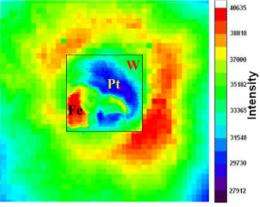Squeezing Information from Materials under Extreme Pressure

(PhysOrg.com) -- By compressing tiny amounts of material between two diamond anvils, scientists have for more than three decades been able to achieve pressures of over 1 million atmospheres. The physical changes and phase transitions that occur under such pressures test theories of solid-state physics and shed light on conditions in planetary interiors. But to gain useful information from highly compressed samples, researchers need probes that resolve fine details of the materials' structure.
A team of scientists has now used nanoscale x-ray beams at the U.S. Department of Energy’s Advanced Photon Source (APS) at Argonne National Laboratory to resolve, on a scale of 250 nanometers, different elements in a mixture of metals, and to obtain diffraction patterns of similarly-sized single crystals in a powder. Such techniques make it feasible to perform measurements at even higher pressures, using smaller diamond anvil cells.
The devices used to create enormously high pressures pose problems for investigations of the compressed samples. Light passes through the diamonds that squeeze the materials, but the resolution of optical measurements can be no better than several hundred nanometers, a typical light wavelength. Electron microscopes have much better resolution, but because they must operate in a vacuum cannot work in conjunction with extreme pressure apparatus.
The short wavelengths of x-rays offer the potential for high-resolution studies, but the x-ray beams at dedicated high-pressure synchrotron beamlines are a few micrometers (μm) across. Because no conventional lens operates in the x-ray regime, making beams narrower is difficult. In recent years, however, a number of synchrotron sources, including the APS, have been able to make available x-ray beams with widths of hundreds of nanometers. These can be produced either using Kirkpatrick-Baez or Fresnel zone.
A team of researchers from Argonne, the Carnegie Institution of Washington (CIW), National Cheng Kung University (Taiwan), and Stanford University used narrow x-ray beams at two beamlines operated by the Argonne X-ray Science Division of the APS to probe a mixture of iron, platinum, and tungsten compressed in diamond anvil cell to pressures up to 2.82 million atmospheres. It took about two years of working closely with scientists at APS nanodiffraction beamlines 34-I-D-E and 2-ID-D to optimize the experimental setup with the diamond anvil cell apparatus so that measurements could be performed, says team member Wenge Yang of the High Pressure Synergetic Consortium (HPSynC) and the High Pressure Collaborative Access Team (HP-CAT), cooperative ventures of CIW and Argonne. At beamline 34-ID-E, Kirkpatrick-Baez mirrors produce a beam 600 nm across, while at beamline 2-ID-D, zone plates produce a beam 250 nm across. For comparison, the scientists also made measurements at the HP-CAT high-pressure beamline 16-ID-B, where focusing beam size is around 5 μm across.
To make the samples, the researchers loaded a mixture of iron and platinum into a 10-µm hole drilled into a sheet of tungsten. They then squeezed the sheet between two diamond anvils with faces measuring 18 μm across. The figure shows a transmission map of x-rays through the sample, obtained by stepping the 250-nm beam across it in 1-μm increments (outer part) or 250-nm increments (central inset). In the inset, the high resolution clearly shows how the three different metals are distributed. Similar results a sample that had already been identified as being predominantly one metal or another yielded distinct x-ray diffraction patterns characteristic of those elements. In contrast, the 5-μm beam produced the same diffraction pattern, including features corresponding to all of the metals, no matter where the beam was focused.
In another set of experiments, the researchers compressed a perovskite mineral, (Mg0.6Fe0.4)SiO3, to 142 GPa, forcing into a different crystal structure, known as postperovskite, that has thus far been only partly characterized. Diffraction measurements using the 5-μm beam produced a complex pattern created by the numerous small crystallites of postperovskite in the crushed sample. But the 250-nm beam produced a much simpler diffraction pattern, from which the scientists concluded that the beam was intersecting a single nanocrystal with a size similar to the beam width. The ability to pick out and study single crystals in a complex sample allows more precise determination of crystal structure.
The success of these techniques for high resolution x-ray studies of materials under extreme pressures makes it feasible to go to still higher pressures, using smaller diamond faces. Ultimately, says team member Lin Wang, he and his colleagues think it is realistic to get useful data from experiments at terapascal pressures, an order of magnitude higher than has been achieved to date.
More information: Lin Wang, "Nanoprobe measurements of materials at megabar pressures," PNAS 107, 6140 (2010). www.pnas.org/content/107/14/6140.full
Provided by Argonne National Laboratory



















